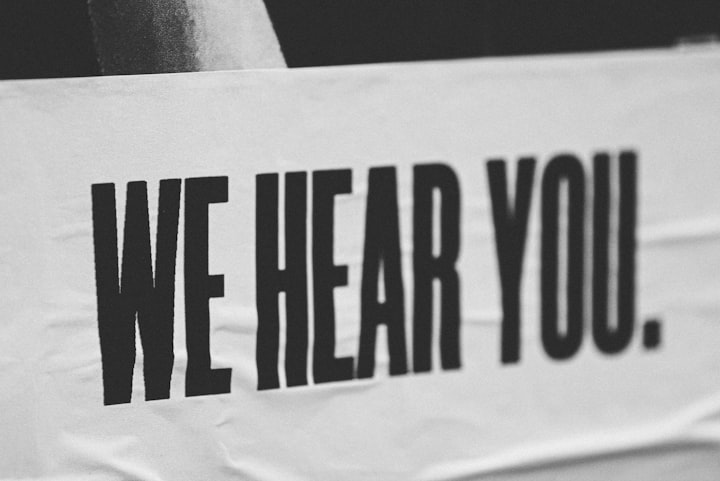How Buying a Hammer Helps Me Be a Better Writer
Be an exceptional writer by serving your readers with kindness.

As I approached the three employees, I could hear them discussing the previous weekend’s party.
“Excuse me,” I started as I approached. “Could one of you help me with a hammer?” (It wasn't really a hammer, but for simplicity, let's substitute a hammer for the product I needed.)
None of the three said a word.
Employee one simply turned and walked away. Rude!
Employee two glared at me like a roach walking across a wedding cake. I feel welcome.
Finally, employee three exhaled heavily. Through some unspoken means, he drew the short straw. He had to help the unwanted customer. He pointed to a display case and then continued talking to employee two.
I knew what hammer I wanted, but I dutifully walked to the display and pretended to browse.
The party conversation continued for another five minutes before employee three walked to a nearby counter to grab a set of keys.
Further Frustration
I’m a happy-go-lucky guy who smiles a lot and can talk to almost anyone, but employee three had no interest in conversation. He said few words to me while retrieving my hammer. What brand, color, etc., but there was no warmth or kindness.
With my hammer of choice finally in my hands, I turned to the cash register. Not ten feet away, I could see there was no one at the register.
I turned back to employee three and asked, “Can you check me out?”
“I don’t do that,” he growled and walked away in the same direction his cohorts had scurried off.
I wish in that moment I had thrown the hammer down and left the store, but that’s not me. I needed the hammer. Living in a small town, there’s not a lot of hammer-buying options unless I want to drive an hour to the closest city.
I walked to the counter and rang a bell next to the sign, “Ring for service.”

Waiting
In the next ten minutes, I watched half a dozen employees mull their way around the store. None even looked in my direction. Finally, one of the lovely darlings dared walk too close, and I asked her for help.
“Can you help me check out?” I asked.
With wide eyes, she shook her head. She resembled a squirrel stuck in the middle of the road, not sure which way to run from my oncoming car.
“Can you find someone who can?”
She groaned—yes, groaned!—and meandered toward the back of the store.
“To earn the respect (and eventually love) of your customers, you first have to respect those customers. That is why Golden Rule behavior is embraced by most of the winning companies.” — Colleen Barrett
It was another five minutes before a tired-looking, thin woman with wide glasses and an oversized jacket came to the register. Without speaking, she scanned my hammer and dropped it into a bag on her side of the counter.
“Nineteen eighty-six.” The only words that came out of her mouth.
I reached into my wallet and grabbed a worn twenty-dollar bill and handed it to her.
She, too, sighed loudly. “I’ll have to get the key.”
Seriously!

I wanted to scream and throw my hammer through the front window of the store. Without asking for another form of payment, the cashier traipsed to the back of the store.
In the next five minutes, I almost started to laugh. I looked around the store to see if there were any cameras. Surely I was being punked. No group of people could really be this rude.
When the cheerful cashier returned, she grabbed my twenty from where she’d left it on the counter and handed me my change and receipt. Again, she said nothing.
“My hammer?” I asked, pointing to the lopsided, thin bag on her side of the counter. She exhaled heavily yet again and handed it to me.
“Thank you,” I said as I took it.
No response.
Shared Experiences
I was dumbfounded. I had experienced poor customer service before, but this event was unbelievable. Every employee treated me like a homeless man at a country club. I didn’t see any bed bugs crawling off of me, but apparently they did. What should have been a five-minute purchase took nearly an hour.
At the time, I worked for an insurance agency. I saw several clients each day. I had a great relationship with most of my insureds, so we would often chat for a few minutes when we saw each other.
My hammer buying experience stayed fresh in my mind, and I couldn’t help but bring it up in conversation.
Every single person I talked to said the same thing, “I hate that place. I only go there if I absolutely have to.”
In the following weeks, I heard dozens of stories similar to mine. That the hammer store stays in business is unbelievable.

Repeat Performance
In the years since, I have only been back to the store one time. I needed another hammer, and I needed it that day. I hoped they were no longer in a locked display, but I was wrong.
It took some hunting to locate an employee. I imagine they tired of having their conversations interrupted on the sales floor and now spend their time in a hidden stock area.
I walked the aisles of the store looking for someone to help and finally found an older woman putting citronella candles on a shelf.
“Excuse me,” I smiled. “Could you help me with a hammer?”
She didn’t even bother to look at me. “I don’t have a key,” she deadpanned and continued with her task.
It was too much. I stormed out of the store, never to return.

Hammers and Writers
You’re probably wondering right now, what do hammers have to do with writers? Let me explain.
As a writer, you are a business. It’s true whether you sell your words or give them away for free. You offer a product—your writing. In exchange, you get something of value—your reader’s time. The way you treat your customers matters.
A client with a poor customer service experience may tell up to 20 people, telling an average of nine to 15 people. This statistic is for person-to-person conversation. A social media share could reach thousands of people. In today’s cancel culture, one negative experience can destroy a business.
A negative customer experience has a 91% chance of the customer never returning, as with me. I will never return to the hammer store.
Treat your readers like you would like to be treated. If they comment on your story, then at the very least, acknowledge their comment. Better yet, take a few seconds to respond. A happy reader will come back. Someone who feels seen will return.
“Successful people are always looking for opportunities to help others. Unsuccessful people are always asking, ‘What’s in it for me?‘” — Brian Tracy

Missed Opportunities
Recently, I commented on another writer’s story on Medium. Her material was useful, but I wanted more information on part of her story. So, like an ideal reader, I left a comment and asked a question.
The writer ignored it. No claps. No response.
Am I going to continue to read her content? Maybe, but I’ll be honest, I’m a little put off by her lack of response. It wasn’t like I just said, “Good story.” I asked a question and was hoping for an answer.
Yes, I know a lot of writers ignore their comments, and maybe when you have millions of followers, that’s okay. It’s your choice. You can choose to silence your readers.
To me, ignoring readers is a terrible idea. Commenting is one of the few ways readers have to connect with you. If you reject that connection, why should they stick around?
In addition, comments tell you what your readers want. My question could have inspired an entire post or series of articles for the writer who ignored me. It’s a missed opportunity for her.
Your readers want to tell you what they need, but you have to listen.
You want your clients to buy their hammers from you. Your success depends on creating a valuable product and treating your customers well. Let the hammer-buying lesson make you a better writer.
Until next time, keep fighting. (And writing.)
Do you struggle to start each day with a positive mindset?
Learn to banish your negative thinking with the free 30 Days of Positivity Email Course. Sign up today!
About the Creator
Scott Ninneman
Bipolar for 49 years, chronically ill for 36. The voice behind the Speaking Bipolar blog. Wrestles taxes by day, wrangles words at night. Thinker. TV Addict. Poet. Links: https://speakingbipolar.com/socialmedia






Comments
There are no comments for this story
Be the first to respond and start the conversation.